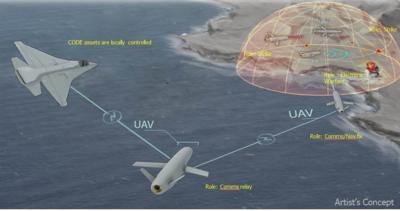Thu, Jan 29, 2015
Software Under Development Enabling Unmanned Aircraft To Work Together With Minimal Supervision
The U.S. military’s investments in unmanned aircraft systems (UAS) have proven invaluable for missions from intelligence, surveillance and reconnaissance (ISR) to tactical strike. Most of the current systems, however, require constant control by a dedicated pilot and sensor operator as well as a large number of analysts, all via telemetry. These requirements severely limit the scalability and cost-effectiveness of UAS operations and pose operational challenges in dynamic, long-distance engagements with highly mobile targets in contested electromagnetic environments.

DARPA’s Collaborative Operations in Denied Environment (CODE) program aims to overcome these challenges by developing algorithms and software that would extend the mission capabilities of existing unmanned aircraft well beyond the current state-of-the-art, with the goal of improving U.S. forces’ ability to conduct operations in denied or contested airspace. CODE researchers seek to create a modular software architecture that is resilient to bandwidth limitations and communications disruptions, yet compatible with existing standards and capable of affordable retrofit into existing platforms.
DARPA has released a Special Notice inviting interested parties to identify their interest in participation in select Phase 1 CODE meetings. DARPA is particularly interested in participants with capabilities, methodologies, and approaches that are related to CODE research and focused on revolutionary approaches to unmanned aircraft systems, autonomy and collaborative operations. Responses to the Special Notice will be used to select the participants and should not contain intellectual, confidential, proprietary or other privileged information.
Two meetings are currently planned: an Open Architecture Meeting and a Technology Interchange Meeting. The Open Architecture Meeting will review the requirements and approaches for making the CODE open architecture compatible with communication-constrained, distributed, highly autonomous collaborative systems. During the Technology Interchange Meeting, invited participants will present technologies for potential incorporation into the demonstration planned for Phases 2 and 3 of the program and ensure that CODE leverages the best available technologies from all possible sources.
The meetings are scheduled for the first week of March 2015 in the Arlington, VA, area.
(DARPA Image)
More News
Terminal Radar Service Area Airspace surrounding designated airports wherein ATC provides radar vectoring, sequencing, and separation on a full-time basis for all IFR and participa>[...]
Aero Linx: Utah Back Country Pilots Association (UBCP) Through the sharing experiences, the UBCP has built upon a foundation of safe operating practices in some of the most challen>[...]
From 2010 (YouTube Edition): Imagine... Be The Change... Inspire FROM 2010: One of the more unusual phone calls I have ever received occurred a few years ago... from Anousheh Ansar>[...]
(Pilot) Felt A Shudder And Heard The Engine Sounding Differently, Followed By The Engine Chip Detector Light On April 14, 2025, about 1800 Pacific daylight time, a Bell 206B, N1667>[...]
Also: AMA Names Tyler Dobbs, More Falcon 9 Ops, Firefly Launch Unsuccessful, Autonomous F-16s The Air Force has begun ground testing a future uncrewed jet design in a milestone tow>[...]
 ANN's Daily Aero-Term (05.07.25): Terminal Radar Service Area
ANN's Daily Aero-Term (05.07.25): Terminal Radar Service Area ANN's Daily Aero-Linx (05.07.25)
ANN's Daily Aero-Linx (05.07.25) Classic Aero-TV: Anousheh Ansari -- The Woman Behind The Prize
Classic Aero-TV: Anousheh Ansari -- The Woman Behind The Prize NTSB Prelim: Bell 206B
NTSB Prelim: Bell 206B Airborne-NextGen 05.06.25: AF Uncrewed Fighters, Drones v Planes, Joby Crew Test
Airborne-NextGen 05.06.25: AF Uncrewed Fighters, Drones v Planes, Joby Crew Test



